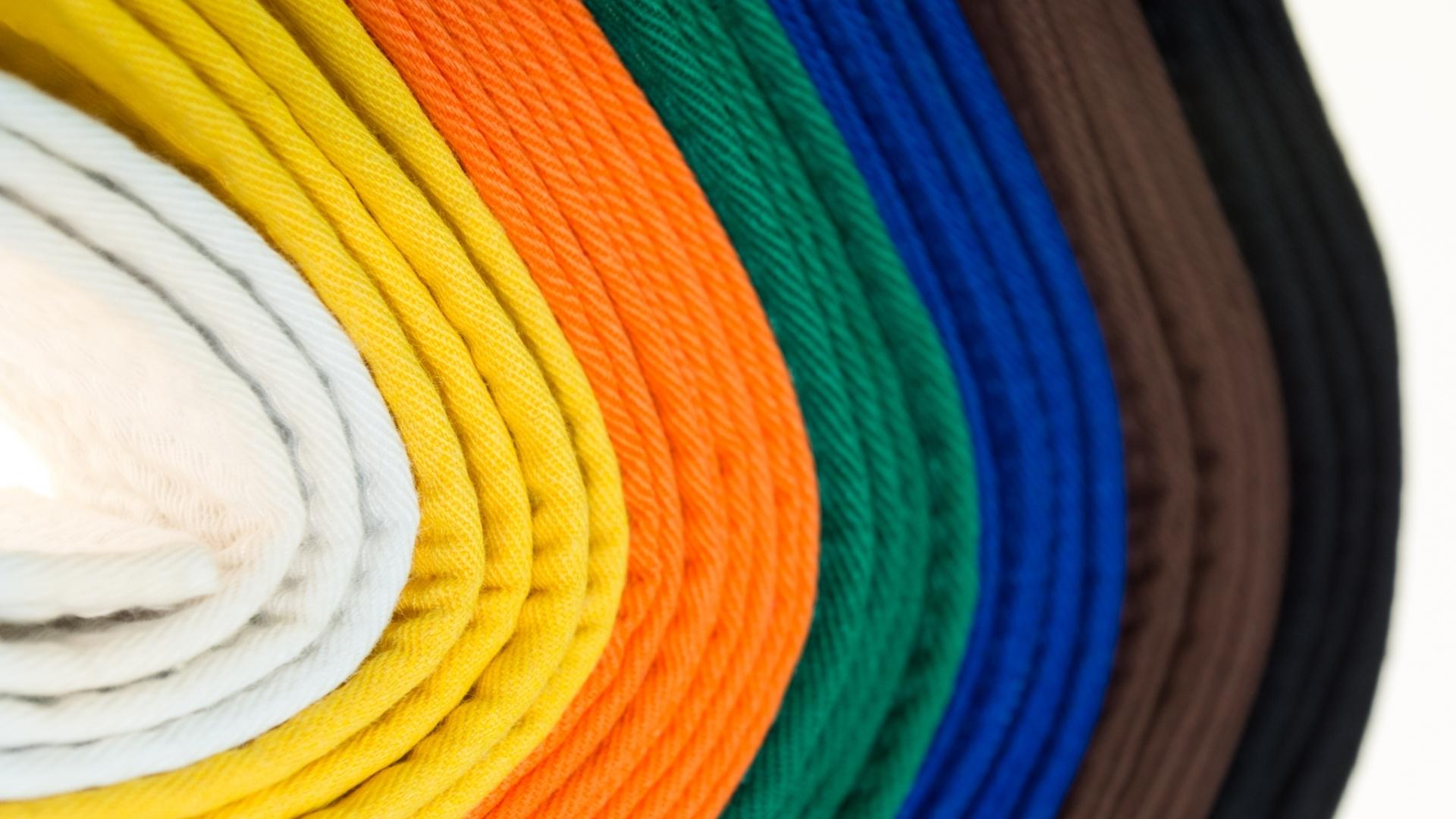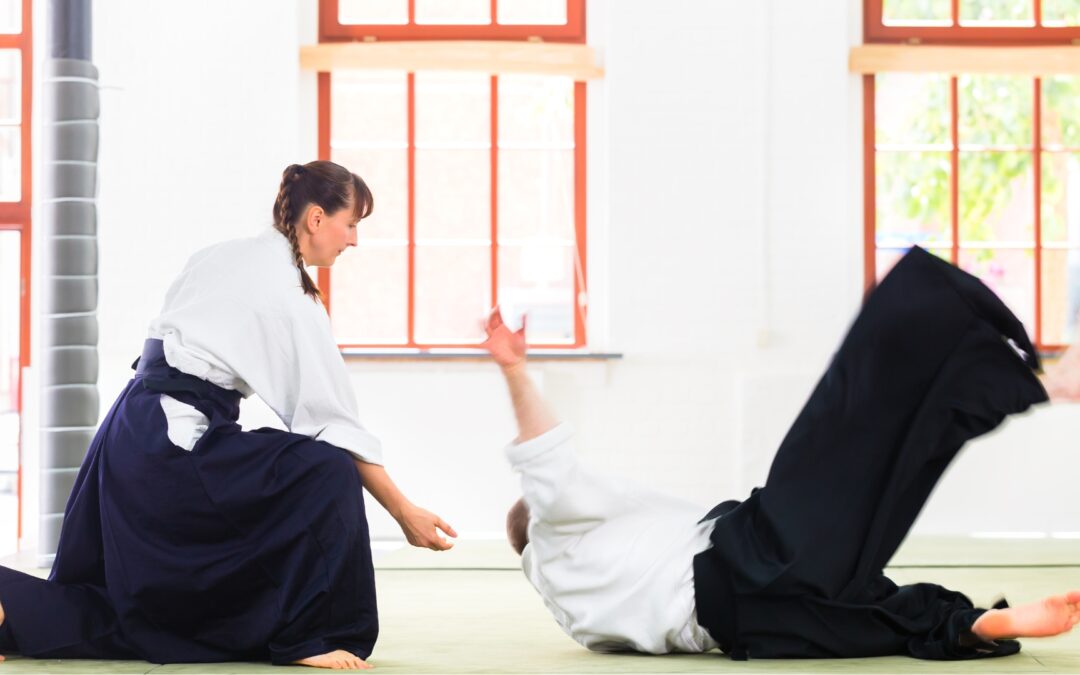Aikido Levels and Equipment
Learning the names of different aikido belts and equipment takes some time. At first glance, many of the terms can be confusing if you’re unfamiliar with the Japanese language. However, aikido equipment is relatively simple in nature. There are a few things every student will need and others that are optional. Here we explore common aikido belts and equipment used in the practice of this traditional martial art.

Aikido Levels
Aikido uses colored belts as a ranking system like many other martial arts. Though most organizations follow a similar system, testing requirements and ranks can vary from one dojo to another. Regardless, aikido students generally move through a series of grades before progressing through black belt degrees.
Most martial arts schools adopted the Kyu/Dan colored belt system that was used by Jigaro Kano, the founder of Judo. He used colored belts to designate various levels (kyu) before black belt. Many students found this useful, not only to designate their own rank, but also to understand the rank of who they were working with.
Aikido belts and standards are different around the globe. Traditionally, aikido belts were either white or black. However, some British dojos began adding colors such as blue, brown, and orange to designate different ranks. Modern aikido ranking encourages students to set and achieve measurable goals.
Beginner aikido ranks typically move from 7th kyu up to 1st kyu. 6th kyu is often shown by a white belt, followed by yellow (5th kyu), orange (4th kyu), green (3rd kyu), blue (2nd kyu), and brown (1st kyu). The rank above 1st kyu is known as 1st dan.
When a student reaches 1st dan, they begin to wear their hakama. Students who earn the rank of 1st dan also receive their black belt. There are ranks above 1st dan up to the 9th and even 10th degree, though they’re reserved for a select few.
Aikido Equipment
There are a few important pieces of equipment that you’ll need to take part in aikido. These include traditional garments and assorted items to aid in training. Keep in mind that many aikido terms have various different names. Below is a list of several types of aikido equipment that you may use in your classes.
1. Gi
A gi (dogi or keikogi) is what aikido students wear when training in this martial art. It’s the most important piece of gear for aikido students, and they must treat it with respect. Most students wear something like a lightweight judo gi since there isn’t a great deal of variation in this item of clothing. A traditional aikido gi is a loose uniform made of white cotton.
2. Hakama
The hakama is a traditional type of Japanese clothing worn in aikido. This item is essentially a loosely fitting pair of trousers. Hakamas tend to vary from one dojo to another, and they usually are either black or blue. One major thing to look for other than color is a thick material with soft padding.
3. Zori
A pair of zori (thong sandals) is another common item for aikido students. While these aren’t used in training, they’re helpful for getting on and off the training mat while keeping your feet (and the mat) clean. Zori are often made of cloth, rubber, leather, wood, or synthetic materials.
4. Bokken
If your aikido training involves the use of weapons, then the bokken is a common one you may need. This is a traditional Japanese wooden sword generally made from oak. While they can be made from other types of wood, oak is often the most affordable. Practice bokken made from bamboo are instead known as shinai.
5. Tanto
Much smaller than a bokken, a tanto is a traditional Japanese knife or short sword. Samurai were known to carry them as a secondary self-defense weapon. Wooden or plastic blades are often used in various aikido techniques to train students in deflecting knife attacks.
6. Jo
Another common aikido weapon is a jo or short staff typically made from oak. A jo is shorter than a bo staff, and aikido techniques involving this weapon are known as aiki-jo. Whether you select red or white oak is a personal choice, as both are similar.
Experience Aikido Firsthand
Simply reading about aikido belts and equipment won’t properly convey their significance. Each of these important items is rooted in history, tradition, and technique.
In order to genuinely appreciate aikido equipment, it’s best to experience them firsthand. We encourage you to stop by our dojo sometime soon for a free trial session. Our growing community of students will welcome you with open arms.

Finding Your Fit: Exploring Unique Martial Arts Styles for Your Kids
Choosing the right martial arts styles for your child is like finding the perfect puzzle piece—it...

Hapkido vs. Aikido: Understanding the Contrasts and Similarities
Comparing Hapkido vs. Aikido showcases these distinct yet interconnected practices, each of which...

How Our Kids Can Learn Nonviolent Resistance Through Aikido
In a world that often feels chaotic and uncontrolled, instilling values of peace and nonviolent...
Visit Us!
PHONE
ADDRESS
4215 South 33rd Street
Lincoln, Nebraska 68506
Hours
Mondays Closed
Tuesday- 5:30 p.m - 8:30 p.m.
Wednesday- 6:30p.m. - 7:30p.m.
Thursday- 5:30 p.m - 8:30 p.m.
Fridays Closed
Saturday- 10 a.m. - 1 p.m.
Sundays Closed
Try a Class!
Interested in trying one of our classes? Choose your class level and schedule a trial appointment today! Discover Aikido and discover yourself!
